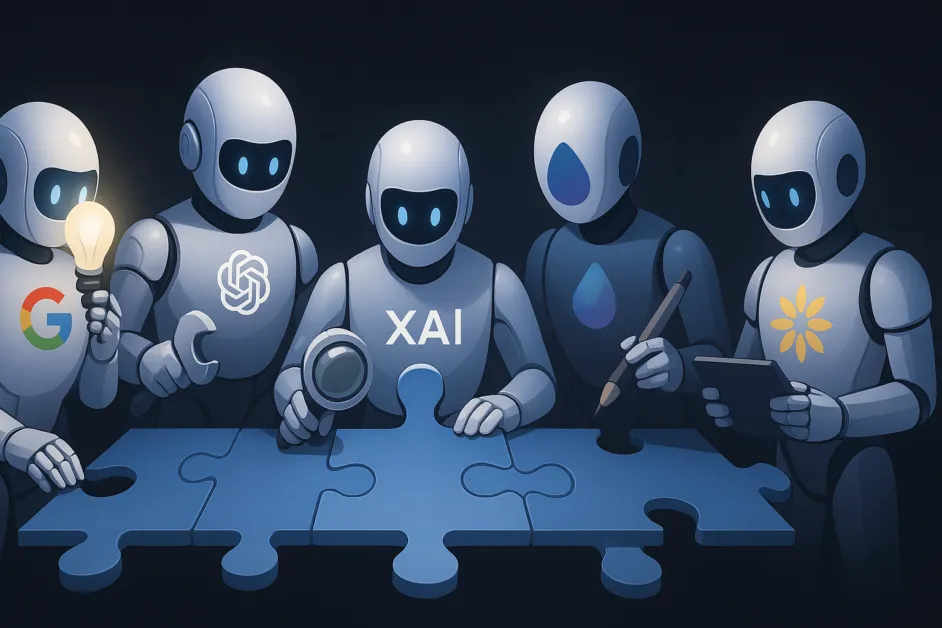The shift from text tracking to advanced reasoning in large language models (LLMs) is gradual, but it is compounding and evolving into an intricate system capable of tackling complex challenges. Predicting a word in a sentence was the primary objective of these models, but they have moved far ahead and are capable of performing mathematical calculations, writing code, and executing business intelligence tasks. This transformation has been accentuated as a result of development of reasoning techniques that enable AI systems to sift and process information logically. This paper focuses on OpenAI’s o3 and Grok 3, DeepSeek R1 and Google’s Gemini 2.0, Claude 3.7 Sonnet models and their reasoning techniques explaining their advantages and comparing performance, cost, and scalability metrics.
NOTE: This is an official Research Paper by “CLOXLABS“
Reasoning Techniques in Large Language Models
Reasoning techniques of LLMs is an important aspect to highlight. When it comes to noticing difference in reasoning for LLMs, there is a need to break down the reasoning techniques the model employs. This subsection covers four primary reasoning techniques to explain how these models reason differently.
● Inference-Time Compute Scaling
Implementing such technique enhances reasoning abilities of the model by providing additional computations on the response generation phase, without changing the core of the model or performing any retraining. It enables the model to “deep think” by executing multiple answer generation, evaluating the answers, and refining them through further steps. For instance, while solving a complex math problem, the model may decompose the problem into subcomponents and solve each sequentially. This is especially beneficial when addressing tasks that require a high level of subsequent thinking, such as coding logic puzzles or other challenging problems. In addition to improving response accuracy, however, the technique causes increased runtime costs and greater latency, which makes it applicable for systems where precision takes precedence over speed.
● Pure Reinforcement Learning (RL)
With this approach, a model is trained to reason through trial and error by rewarding correct answers and punishing incorrect ones. The model engages with an environment, which can be a collection of problems or tasks, and improves by changing its actions based on what its feedback. For example, when it comes to writing code, the model is likely to try out different solutions and cash in on a reward if the code runs correctly. This tends to mimic how a person learns a game by practicing and allows the model to cope with new challenges over time. Yet RL is completely self-contained, which can be very costly from a computational perspective and sometimes unstable. The model may use some “shortcuts” which do not truly represent understanding.
● Pure Supervised Fine-Tuning (SFT)
This approach improves reasoning by teaching the model to use high-quality labeled datasets created by humans or stronger models. It learns to imitate correct reasoning patterns through examples, making it efficient and stable. For example, in order to improve its capability of solving equations, the model might learn from a set of solved problems by following the steps in a procedural manner. This technique is simple and inexpensive, but strongly depends on the quality of the data. If the examples provided are poor or small in number, the model might perform poorly and face challenges outside its training. Pure SFT works best for well defined problems.
● Reinforcement Learning with Supervised Fine-Tuning (RL+SFT)
The approach combines the stability of supervised fine-tuning with the adaptability of reinforcement learning. Models first undergo supervised training on labeled datasets, which provides a solid knowledge foundation. Subsequently, reinforcement learning helps refine the model’s problem-solving skills. This hybrid method balances stability and adaptability, offering effective solutions for complex tasks while reducing the risk of erratic behavior. However, it requires more resources than pure supervised fine-tuning.
Reasoning Approaches in Leading LLMs
Now, let’s examine how these reasoning techniques are applied in the leading LLMs including OpenAI’s o3, Grok 3, DeepSeek R1, Google’s Gemini 2.0, and Claude 3.7 Sonnet.
– OpenAI’s o3
To improve reasoning, OpenAI’s O3 implements Inference-Time Compute Scaling. Because other resources can be allocated to computing during response generation, sophisticated tasks such as mathematics and coding are completed seamlessly. Hponse O3 performs outstandingly during the benchmarks for ARC-AGI tests. However, increased inference costs and lowered response time do present some limitations, meaning it is most appropriate in scenarios where high levels of accuracy are necessary for research and technical problem-solving.
– xAI’s Grok 3
Grok 3, developed by xAI, found a way around this problem by pooling resources through co-processors designed for specific tasks, such as symbolic mathematical manipulation, in addition to implementing Inference-Time Compute Scaling. Archtecturally speaking, these capabilities enable Grok 3 to obtain very large amounts of information in a very short period of time, therefore is able to perform sophisticated tasks in real time, such as financial and live data analysis. Although Grok 3 has no issues with performing tasks in a timely manner, its rapid performance might drive cost through the high computational demands. This model is very effective in situations where both speed and accuracy are critical.
– DeepSeek R1
DeepSeek R1 starts by training its model using Pure Reinforcement Learning, which allows the model to develop its own solving strategies using trial and error. This enables DeepSeek R1 to be flexible and capable of tackling unfamiliar and complex tasks, such as advanced mathematics or coding. Unfortunately, DeepSeek R1’s outputs can be erratic with Pure RL, but he resolves this in later stages by adding Supervised Fine-Tuning, which improves output consistency and coherence. A hybrid approach like this makes DeepSeek R1 less expensive for applications where flexibility is prioritized over sharp responses.
– Google’s Gemini 2.0
Google’s Gemini 2.0 adopts a hybrid approach for improvement, very likely consisting of Inference-Time Compute Scaling and Reinforcement Learning, to heighten the model’s reasoning ability. This model has been geared towards accepting multimodal inputs, including texts, images, and audio, with real-time reasoning performance as its strongest suit. Its strength lies in managing pre-responding information to ensure accuracy, particularly with complex queries. However, like Gemini 2.0, other models that cost a lot to run tend to use inference-time scaling, so it works best for multimodal reasoning applications like interactive aides and data analysis systems.
– Anthropic’s Claude 3.7 Sonnet
Claude 3.7 Sonnet from Anthropic integrates Inference-Time Compute Scaling with a focus on safety and alignment. This enables the model to perform well in tasks that require both accuracy and explainability, such as financial analysis or legal document review. Its “extended thinking” mode allows it to adjust its reasoning efforts, making it versatile for both quick and in-depth problem-solving. While it offers flexibility, users must manage the trade-off between response time and depth of reasoning. Claude 3.7 Sonnet is especially suited for regulated industries where transparency and reliability are crucial.
OUR THOUGHTS
The advancement of AI technology made a giant leap with the transformation from simple language models to more advanced systems capable of reasoning. In Modern AI models such as Open AI’s o3, Grok 3, DeepSeek R1, Gemini 2.0 and Claude 3.7 Sonnet, simple Inference-Time Compute Scaling, Pure Reinforcement Learning, RL+SFT, and Pure SFT techniques have been modified to achieve better performance in solving complicated real-life problems. Each models’ reasoning approach defines its strength, which ranges from o3’s comprehensive and systematic reasoned problem-solving to DeepSeek R1’s economically flexible problem-solving. The further these models advance, the more they will enable AI to become an effective solution for real-world problems.
CLOXMAGAZINE, founded by CLOXMEDIA in the UK in 2022, is dedicated to empowering tech developers through comprehensive coverage of technology and AI. It delivers authoritative news, industry analysis, and practical insights on emerging tools, trends, and breakthroughs, keeping its readers at the forefront of innovation.









